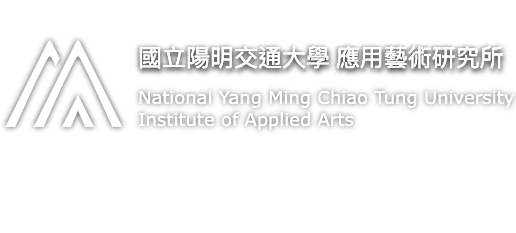INTRODUCTION
Purpose
The 21st century witnesses the close integration of technology into our quotidian existence, which is characterized by increasingly diversified environmental and ecological issues, humanistic critical thinking, technological industries and technical applications, along with a growing trend towards cross-industry and strategic alliances. Design and art undoubtedly play a crucial role in blending future technology into human life and fostering the symbiotic relationship between humanity and ecology. Against this background and harnessing the National Chiao Tung University’s strength in informational technology, the Institute of Applied Arts (IAA) was founded in 1992 and has kept abreast of modern developments to date. It is now underpinned by three pillars — industrial design, transdisciplinary art, and future technology — intended to explore the theories and applications in each field and meanwhile highlighting hands-on experience, idea exchange and fusion of theories.
Applying humanistic concern and artistic thinking, the IAA treats technology and design as its instruments, committing itself to theory construction and practical creation in the fields of transdisciplinary art, future technology and design. It also aims to incubate designers and artists by equipping them with comprehensive knowledge, a global vision, humanistic literacy, as well as a good command of media technology and artistic creation. Based on its concrete creative practice and solid theoretical foundation, the IAA further endeavors to promote its own development, position itself in the international context, build a harmonious learning environment, encourage exchange and enlightenment among different disciplines, and utilize future technology in transdisciplinary design and artistic practice, insofar as to create more thought-provoking opportunities.
A Pioneer That Keeps Transcending Itself
National Yang Ming Chiao Tung University’s critical five years under the “Higher Education Sprout Project” just started. By reference to the emerging trends of the next decade and relying on its forward-looking horizons and special expertise, the IAA breaks away from a follower’s frame of mind, proposing innovative ideas and methods for academic research and teaching practice with driving ambition, holistic thinking, and great potentials. The symbiotic cooperation between the IAA and the other institutions of the National Yang Ming Chiao Tung University is illustrated below:

Orientation
The IAA’s kernel objective in the next decade is to seamlessly blend art, design and theory into emerging technologies (e.g. interactive technology, artificial intelligence, robotics, IoT, and AR/VR/MR). We expect to go beyond the scope of industrial design, visual communication and technology art, thereby expanding our horizons with “art, technology and design” as our distinguishing features as well as creating unprecedented interactive products and a brand new paradigm of transdisciplinary art. In the relational trinity of “art, technology and design,” technology is our main strength supported by art and design. It implies that the IAA orientates itself towards a comprehensive team that allows technological development to take root within its institutional framework. Apart from putting internal transdisciplinary integration into practice, the IAA also engages in active collaboration and dialogue with its foreign and domestic counterparts in exploring new transdisciplinary possibilities and the unknown.
By virtue of its practical experience and creative energy accumulated over the years, the IAA has delivered a high level of performance in various fields, such as transdisciplinary art, media anthropology, psychology of art, empirical aesthetics, technological art and dance, UI, UX, AR/VR/MR, human-machine interaction design, service design, and experience design. It also has an impressive record of achievement in transdisciplinary design, creation and theory-building, in which its innovative power and strength regarding transdisciplinary
cooperation find expression. To meet its forward-looking, transdisciplinary, and integrative orientation, the faculty’s specializations are divided with equal emphasis according to the three main pillars, i.e. technology, art and design. Besides, a two-pronged strategy on practice and theory has been employed to link the IAA up with the latest international trends.
In terms of technological innovation, the IAA plans to devote itself to the research and application of integration-based, future-oriented “interactive design” and “transdisciplinary art” (e.g. product design and user research, wearable technology, display technology, tangible interface, human-machine interaction design, and applications of transdisciplinary art). Since software-hardware integration and transdisciplinary communication skills will soon become the core competences for students of design and art, the IAA’s orientation completely fits in with the requirement of blurring the boundaries between natural sciences and humanities in today’s higher education, which ergo empowers students of natural sciences to develop critical humanistic literacy on the one hand, and students of art and design to learn the very foundation of interactive technology on the other. In terms of software-hardware integration, the IAA sets great store by improving students’ command of design
tools. The IAA’s accentuation on learning software-hardware integration is not so much about training students into IT engineers as about turning the tools used by engineers and scientists into part of design materials, because new materials can not only stimulate students’ creativity but also help them evolve their design thinking as practical as innovative in the age of Industrial 4.0. Students will also tackle thorny design problems from a broader perspective when learning to avail themselves of new instruments. Such a process of iterative prototyping constitutes an indispensable training whether for design or human-machine interaction. In terms of transdisciplinary communication, students of art and design share a common language with engineers and scientists, so that they are competent to partake and having a say in product design and innovation, and ultimately establish a significant presence in every phase of production.





